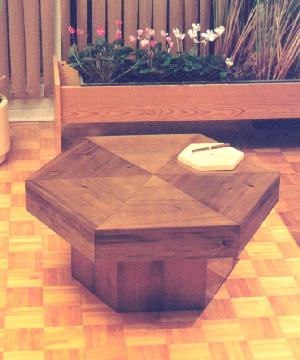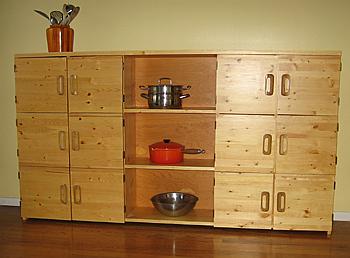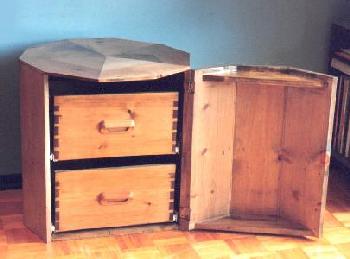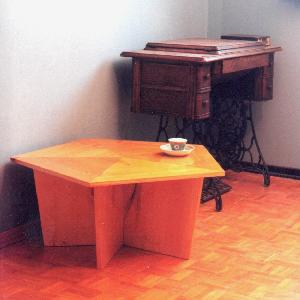The best book that I have found on wood finishing (non-paint) is by Bob Flexner, "Understanding Wood Finishing" (Rodale Press). It gets more things right than any book I have ever read on the subject. If you love woodworking, get it. But, it advises to just use clear varnish or paint on pine!
I usually use 2x18 cm ("1x8") furniture grade eastern white pine. At $20/m² Canadian, it's one of the cheapest quality woods around, with lots of nice grain swirls and iridescent knots. I pick out a few of the most knot-free boards and resaw them to 1 cm thickness for backs, leaving the more interesting looking pieces for parts that are seen the most. Most of the scraps are glued up for turning into bowls and vases.
As any cabinetmaking book will tell you, wood moves. When building up a large surface by edge-gluing, choose your boards so that, when they are glued up, the grain curves mechanically balance each other. Design your furniture structure so that all surfaces in the same plane have the grain running the same way, to minimize stress from seasonal change. I prefer hardwood dowels for reliability where grain must join at right angles, rather than tenons which tend to fracture at corners. Pine is weaker and more flexible across the grain than most hardwoods, so ensure the design of your structure takes that into account. And, of course, you will choose your boards so that the appearance of the most visible parts of your work is as visually balanced and attractive as possible. But all this is well covered in books. On to what isn't.
Finish materials
In a finishing store, physical chemists have a fit with the names used for things! True oils are liquids, the stuff that drips out of your car onto your driveway - the last thing you want around fine wood. What you want are lacquers or varnishes. A lacquer is a solid, dissolved in a solvent that evaporates after application, that can be re-dissolved by a solvent at any time. A varnish is a material that changes to a solid after application, so any solvent or thinner used for its application won't dissolve the cured finish.
Shellac is a lacquer. It's food safe - in fact it's used for candy coatings. It can be refined and dewaxed (blonde), just refined (orange) or raw ('button lac'). The Cremona violin makers used orange shellac (Stradivarius added orange dye to accentuate the colour), as did most early cabinetmakers in Ontario - it lasts hundreds of years if looked after. It's cheap, seals wood well against humidity changes, is easy to apply with a brush, repairs easily, and takes a polish beyond compare. However, if you are making a table top, shellac is not the material to use - it re-dissolves in alcohol (beer/wine spills), whitens irreversibly with moderate heat (hot food), and melts with high heat. And it's not as environmentally friendly a product as it once was - it is now collected by stripping the bark from the East Asian trees on which lac bugs (Coccus lacca, a scale insect) live and shipping it off to be dissolved in industrial solvents, instead of being scraped renewably off the bark every few years and dissolved in local grain alcohol as it used to be.
Tung oil is a varnish. Squeezed from tung nuts (Aleurites fordii), a renewable resource, it oxidizes on exposure to air and becomes a solid resin by polymerization. It has been used for at least a millennium in China in its raw state - it lasts a long time. Like shellac it seals wood well against humidity changes, is easy to apply with a brush, and repairs easily. It brings out the natural colour of wood better than shellac. But, it's more expensive, requires more coats, and is harder to put a fine polish on. The raw oil contains toxins (don't drink it!) but these are destroyed by the drying process - the finish is FDA-rated food-safe.
Linseed oil, from flax seeds, is also a varnish - our ancestors used it for farm implements, not fine furniture, and that's where it belongs. There are many excellent modern nitrocellulose lacquers, and varnishes made from phenolic, alkyd and urethane resins, but they require solvents that can cause too many health problems for my liking. Water-based coalescing varnishes are health safe, but difficult to apply so they stay clear, don't bring out the figure of pine as well as tung oil, and don't seal wood well against humidity changes either. However, they do take a good polish if applied thick, scraped smooth, then polished with a buffer loaded with rottenstone.
A dye is a colourful molecule dissolved in a solvent - transparent, so wood shows through it. In paint stores, 'stain' means pigment, chunks of coloured material that block the view of wood it is applied to. As a wood lover, I stick to dyes. Unfortunately, almost no one uses dyes for finishing wood any more, in fact most paint store people don't even know what you mean by the term! The most widely used wood dyes are aniline. They dissolve in water, are available in every colour of the rainbow, and revolutionized furniture finishing in the past century when they were developed. My favourite anilines are a gray mix with the calm character of antique pine and a black mix of colour similar to the solid walnut furniture made here before the big trees were all cut down. (Lee Valley carries them.) However, a warning: shellac (orange or button lac) under tung migrates through the tung and leaves the finish increasingly sticky with time, then so soft it's almost fluid!
Staining
I work surfaces flat and square with a plane, then sand with 320 grit garnet paper and a small-orbit finishing sander. My aim in sanding pine after planing it is not to smooth the surface, it's the opposite - to roughen it as finely and evenly as possible so that stain applies evenly. If you skimp on sanding, stains will blotch on pine - you will get highly-stained patches that are not visually related to the grain pattern. If you are going to use tung oil, round ('break') edges a bit more than you would normally. Tung climbs up on edges as it dries, a useful trait to strengthen the finish at exposed points, but one which should be prepared for.Pine is so absorbent that it is easy to overstain it. In fact, it's next to impossible to keep end grain from getting overstained - it's easiest to design your furniture so it looks good that way. I get best results on pine from mixing aniline stain extremely dilute - 5 ml powder in a liter of water, about 1/20th the concentration marked on the packets. I begin by heating the stain mix to hand-hot, to reduce blotching caused by traces of oil and resin in the pine. Then I pre-wet exposed end grain with plain water, apply a wash of stain over the entire surface, and rub in a bit of extra plain water immediately on areas that look too dark. Applying water this generously makes the surface of the wood expand, so to keep everything true I apply stain to all surfaces, inside and out, so the wood stays in balance. 'Grain raising' is minimal when the surface of the wood is sufficiently finely notched up by sanding - the grain is actually raised everywhere, but so evenly and in such short tufts that it is bridged over by the finish.
Let it dry a full day, then look it over. The beauty of dye is that you can move it after it's in place - apply extra water to lighten, extra stain to darken, different stain mix to blend colours. Practise doing this on scrap pieces until you get the knack of feathering the edge of such corrections so they don't show - I find a small brush moistened with boiling water handy for this. Once it looks the way you want it, let it dry until the surface is totally dry, crisp to the touch - at least three days in dry weather, more in humid. Otherwise, your finish can move the stain around.

coffee table & cheese board. table: 'walnut' stain, tung oil. board: blonde shellac.

sideboard. prejoined lodgepole pine, tung oil.

display pedestal & file cabinet. 'antique grey' stain, tung oil.

computer workstation. dark 'walnut' stain, tung oil.

tea table. yellow shellac, tung oil after 20 years !!